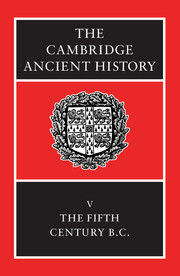Book contents
- Frontmatter
- Contents
- List of maps
- List of text-figures
- Preface
- 1 Sources, chronology, method
- 2 Greece after the Persian Wars
- 3 The Delian League to 449 b. c.
- 4 The Athenian revolution
- 5 Mainland Greece, 479–451 b. c.
- 6 The Thirty Years' Peace
- 7 Sicily, 478-431 b.c.
- 8 Greek culture, religion and society in the fifth century b.c.
- 8a Art: Archaic to Classical
- 8b Classical Cities and Sanctuaries
- 8c Rebuilding in Athens and Attica
- 8d Panhellenic Cults and Panhellenic Poets
- 8e Athenian Cults and Festivals
- 8f Athenian Religion and Literature
- 8g Society and Economy
- 8h Athens as a Cultural Centre
- 9 The Archidamian War
- 10 The Peace of Nicias and the Sicilian Expedition
- 11 The Spartan Resurgence
- Chronological Notes
- Chronological Table
- BIBLIOGRAPHY
- Index
- 1 Greece and Western Asia Minor
- References
8a - Art: Archaic to Classical
from 8 - Greek culture, religion and society in the fifth century b.c.
Published online by Cambridge University Press: 28 March 2008
- Frontmatter
- Contents
- List of maps
- List of text-figures
- Preface
- 1 Sources, chronology, method
- 2 Greece after the Persian Wars
- 3 The Delian League to 449 b. c.
- 4 The Athenian revolution
- 5 Mainland Greece, 479–451 b. c.
- 6 The Thirty Years' Peace
- 7 Sicily, 478-431 b.c.
- 8 Greek culture, religion and society in the fifth century b.c.
- 8a Art: Archaic to Classical
- 8b Classical Cities and Sanctuaries
- 8c Rebuilding in Athens and Attica
- 8d Panhellenic Cults and Panhellenic Poets
- 8e Athenian Cults and Festivals
- 8f Athenian Religion and Literature
- 8g Society and Economy
- 8h Athens as a Cultural Centre
- 9 The Archidamian War
- 10 The Peace of Nicias and the Sicilian Expedition
- 11 The Spartan Resurgence
- Chronological Notes
- Chronological Table
- BIBLIOGRAPHY
- Index
- 1 Greece and Western Asia Minor
- References
Summary
STYLE AND ICONOLOGY
Archaic Greek art, with roots stretching back to the Geometric style of the eighth century b.c., had been concerned with forms whose effectiveness was judged not so much by the degree to which they simulated one's optical experience of the surrounding world as by the degree to which their internal properties of harmony and clarity expressed an essential idea. Archaic artists did not so much imitate nature as create analogues for it. They did this by dissecting the components of natural phenomena into their fundamental geometric forms and then recomposing these forms according to principles of symmetria, the commensurability of parts. Works of representational art resulting from this process may not have looked exactly like their counterparts in nature, but they were not intended to. What was expressed by such familiar products of the Archaic style as the kouroi, for example, was more in the nature of an eidos, simultaneously a ‘form’ and an ‘idea’, than an imitation. Until well on into the Hellenistic period an interest in defining underlying structures through works of art, structures which evoked immutable ideas, continued to be of great importance in Greek art, but from the fifth century b.c. onward this interest was increasingly combined with a desire to record a wider range of natural appearances. To a great extent it is the interplay between traditional idealism and a new empiricism that gives the art of the Classical period its distinctive character.
Keywords
- Type
- Chapter
- Information
- The Cambridge Ancient History , pp. 171 - 183Publisher: Cambridge University PressPrint publication year: 1992



